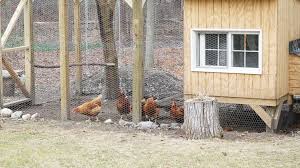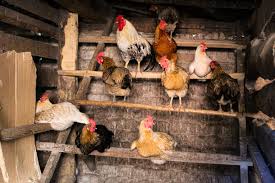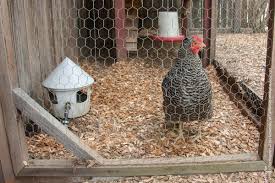What Should Be Inside Your Chicken Coop? Essential Elements for a Functional and Productive Coop
Imagine stepping into your backyard, inhaling the fresh air, and hearing the content clucking of your happy hens.
To make bring your imagination to live you then decided to keep a few chickens, which will require building a chicken coop.
But have you ever wondered what makes a chicken coop truly functional and productive?
So in this blog post, we are going to look at what should be inside your chicken coop to ensure the comfort, health, safety, and
productivity of your chickens.

I. Proper Size and Layout: Creating Space for Your Chickens to Thrive
The size of your chicken coop is something you should really pay attention to while building because providing enough space for your birds is important for their well-being and productivity. Discover the optimal coop size and layout to accommodate your flock's needs.
1. Determining the Ideal Coop Size for Your Flock
To ensure your chickens can move around comfortably, aim for at least 4 square feet of indoor space per chicken. Consider factors like breed, size, nesting boxes, and the amount of time your chickens spend inside the coop to determine the perfect size for your flock.
2. Why You should not Compromise Space
Ample space prevents overcrowding and reduces stress among your chickens. It also minimizes the risk of diseases and parasites. You should provide enough room for your chickens to exercise, stretch their wings, and engage in natural behaviors which is crucial for their overall health and happiness.
II. Ventilation and Lighting: Creating a Healthy and Productive Environment
Proper ventilation and lighting are vital components of a well-equipped chicken coop. Optimize these factors to ensure your chickens thrive and lay delicious eggs.
1. The Role of Ventilation in Maintaining a Healthy Coop
A good airflow prevents the buildup of harmful gases, such as ammonia, which can impact your chickens' respiratory health. Use effective ventilation strategies to regulate temperature, control humidity, and maintain a clean and healthy coop environment. I prefer chicken coops with vents placed above 4 to 5 feet. This will prevent draught and chills, especially against baby chicks.
2. Optimal Lighting in Chicken Coop for Productivity and Well-being
Providing the right lighting conditions for your chickens is essential. Adequate exposure to natural light or artificial lighting supports egg-laying patterns, healthy feather development, and the overall well-being of your flock. Explore tips for creating the perfect lighting setup inside your coop. Setting a light on a timer that turns on in the early morning hours is the best recommendation. Generally, laying hens require between 16 to 18 hours a day. So, you can set the timer to meet up with the required amount of light, if there is a change in weather- longer nights/shorter days. Also read:: 7 Ways On How To Winter Chickens To Keep Them Warm
III. Sturdy Construction and Predator-Proof Chicken Coop: Building a Safe Haven for Your Flock
A well-built predator-proof chicken coop not only offers shelter but also protects your precious chickens from predators.
You may be wondering how I make my chicken coop predator-proof.
Here is how you go about it...
Explore the importance of sturdy construction and effective predation protection measures.

1. Choosing Durable Materials for Longevity
To build a predator-proof chicken coop you should source the best materials for constructing your coop, ensuring durability and longevity. From sturdy woods to durable metals, select materials that withstand can withstand harsh weather and the wear and tear of daily use.
2. Implementing Effective Security Measures to Protect Your Flock
Keep predators at bay by implementing robust security measures. Explore techniques such as secure fencing, reinforced doors and windows, and predator deterrents to safeguard your chickens and provide peace of mind.
IV. Comfort and Convenience: Features to Enhance Your Chicken Coop's Functionality
Make your chicken coop a comfortable and convenient space for both you and your flock. Explore essential features that promote nesting, resting, and efficient management.
1. Nesting Boxes and Roosting Bars: Encouraging Egg-Laying and Restful Roosting
the importance of well-designed nesting boxes that provide privacy and cleanliness for your hens' egg-laying needs. Learn how to create comfortable roosting spaces that accommodate your chickens' size and promote restful sleep. Here are some details on nest box sizes to consider for your chicken coop:
Size Considerations:
Each nest box should be spacious enough to accommodate one hen at a time comfortably. For a standard nest box, you can use these dimensions For a standard nest box, you can use these dimensions 12 -14 inches (30-35cm) in width, 12-14 inches ( 30- 35 cm ) in height, and 12 -14 inches (30 -35 cm ) in depth. The size can vary depending on the breed and size of your hens. Larger breeds may require slightly bigger nest boxes to accommodate their size.
A number of Nest Boxes:
It is recommended to have one nest box for every 3-4 hens

Roosting Bar Chicken Coop Tips:

2. Bedding Material and Waste Management: Maintaining Cleanliness and Hygiene
Choose the right bedding material that offers insulation, moisture absorption, and odor control. Explore the benefits of straw, wood shavings, or shredded paper as bedding options. Learn effective waste management techniques to keep your coop clean, minimize odors, and reduce the risk of bacterial infections.
Tips For placing Bedding Materials for Chickens:
Absorbency: Select bedding materials with excessive absorbencies, such as straw, tree shavings, or shredded paper, to correctly soak up moisture and give up the buildup of odors. Comfort: Provide a comfortable surface for your chickens to walk and rest on by choosing soft bedding materials that offer cushioning. Availability: Consider using locally available bedding materials to ensure convenience and easy replenishment. Dust-free: Opt for dust-free bedding options to promote respiratory health and reduce the risk of respiratory issues among your flock. Easy to clean: Choose bedding materials that are easy to clean and replace, allowing for regular maintenance and keeping your coop fresh and hygienic.
3. Feeding and Watering Systems: Easy Access to Nutrition and Hydration
Optimize your chickens' feeding and watering experience by selecting appropriate feeders and waterers. Explore gravity
feeders, treadle feeders, and nipple waterers that provide easy access to fresh food and water while minimizing waste and
contamination.

V. Additional Considerations for a Healthy Environment: Temperature Regulation and Outdoor Space
Take your chicken coop to the next level by addressing temperature regulation and providing outdoor space for your flock's exercise and natural behaviors.
Adequate Temperature Regulation: Comfort in All Seasons
Maintain optimal temperatures inside your coop to ensure the health and well-being of your chickens. Explore insulation techniques, ventilation adjustments, and supplemental heating or cooling options for extreme weather conditions.
Ample Space for Exercise and Foraging: Promoting Natural Behaviors
Provide sufficient outdoor access or a dedicated run area for your chickens to exercise, scratch, peck, and forage. Enhance their physical and mental well-being by offering opportunities to exhibit natural behaviors and explore their surroundings.
VI. Coop Cleanliness and Pest Control: Promoting Health and Preventing Infestations
Maintaining a clean coop and implementing effective pest control measures are crucial for your flock's health and productivity.

Establishing Cleaning Routines and Maintaining Hygiene
Learn the importance of regular coop cleaning and disinfection to prevent the buildup of pathogens and maintain a hygienic environment for your chickens. Establish cleaning routines and proper waste disposal practices for optimal coop cleanliness.
Preventing and Managing Common Pests and Parasites
Implement preventative measures to protect your flock from common pests and parasites. Explore coop design considerations, natural pest control methods, and regular health checks to minimize infestations and keep your chickens healthy and thriving. Conclusion: Your chicken coop is more than just a shelter. It's a home for your feathered friends, a source of fresh eggs, and a symbol of your sustainable living journey. By incorporating the essential elements discussed in this blog post—proper sizing and layout, ventilation and lighting, sturdy construction and predation protection, nesting boxes and roosting bars, bedding material and waste management, feeding and watering systems, temperature regulation, ample exercise, and foraging space, cleanliness, and pest control—you can create a functional and productive environment for your flock. Remember, a well-equipped chicken coop not only benefits your chickens but also enhances your own experience as a chicken keeper. So, embrace these guidelines, implement them in your coop design, and enjoy the rewards of a comfortable, healthy, and thriving flock. Happy chicken-keeping!